Karl Shuker's Blog, page 67
February 21, 2012
QUEST FOR THE KONDLO - ZULULAND'S FORGOTTEN MYSTERY BIRD
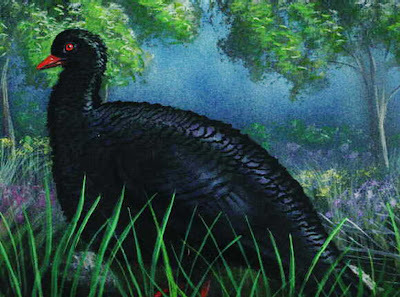 Artistic representation of the kondlo (William Rebsamen)
Artistic representation of the kondlo (William Rebsamen)One of many little-reported cryptozoological birds in need of an identity is Zululand's mysterious kondlo - a large, black, fowl-like bird that incited a considerable conflict of opinion within the pages of the periodical African Wild Life during the early 1960s, yet which nowadays is all but forgotten.
Its principal champion was Captain G.T. Court of Durban, South Africa, whose letter of December 1962 described the kondlo as a voiceless bird comparable in size and shape to a young female domestic turkey poult, with a feathered head and beak also resembling a hen turkey's. Its irises, beak, legs, and feet were red, but its plumage was glossy black, overlain with a greenish-blue sheen - all of which gave it a colouration reminiscent of the chough Pyrrhocorax pyrrhocorax, a species of European crow. It did not seem to exhibit sexual dimorphism (morphological differences between the sexes).
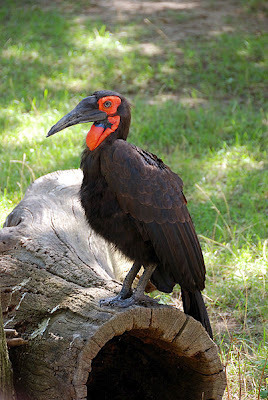 Southern ground hornbill (Wikipedia)
Southern ground hornbill (Wikipedia)During the series of interchanges published in African Wild Life, the southern ground hornbill Bucorvus leadbeateri and the bald ibis Geronticus calvus were offered as putative identities, but both were vehemently rejected by Captain Court. His views were based upon personal experience of the kondlo - from many years of hunting, not only was he fully acquainted with every species of game bird in this region of South Africa, but in addition he had actually shot and eaten several specimens of kondlo. Consequently, he was readily able to differentiate between the ground hornbill, bald ibis, and kondlo.
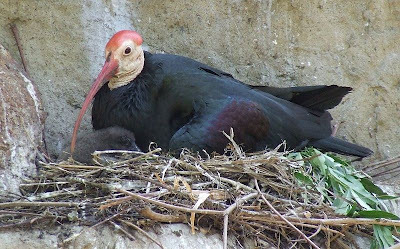 Bald ibis (Althepal/Wikipedia)
Bald ibis (Althepal/Wikipedia)Furthermore, quoting from a scholarly Zulu-English dictionary compiled by priest Father Alfred Bryant during many years of work here, Court pointed out that these three birds even had their own wholly separate local names. The ground hornbill was known as the tsingizi, the bald ibis was the xwagele, and the kondlo was only ever termed the kondlo.
According to Court, this mystifying bird occurred in groups of 4-8 on the grass-covered ridges of Mtonjaneni and Mahlabatini, and when it took to the air it flew low, in a manner resembling the flight of a guineafowl. Ominously, Court also noted that although once abundant, the kondlo seemed lately to be disappearing from its former haunts; his most recent sighting was in about 1956. Surely this species could be systematically sought and conclusively identified by ornithologists - always assuming that it hasn't already died out?
This ShukerNature blog post is excerpted from my book Mysteries of Planet Earth: An Encyclopedia of the Inexplicable (Carlton Books: London, 1999).
Published on February 21, 2012 20:58
February 16, 2012
PREDATOR DEATHMATCH - MEET NICK MOLLOY AND HIS BATTLES OF THE BEHEMOTHS!

Over the years, I have penned a number of forewords to other writers' books, the vast majority of which have been, to varying extents, of a cryptozoological nature. However, in recent times there has been one very notable exception to this trend – Nick Molloy's superb book Predator Deathmatch. I soon discovered that not only was it unlike any book that I'd contributed a foreword to before, but it was unlike any book that I'd ever read before – and it thoroughly captivated me.
Consequently, as I'm sure that you'll enjoy this uniquely engrossing book just as much as I have done – and continue to do – here is my foreword to it, which explains precisely why I consider it so special, and why I feel certain that once you've bought it and read it you will too.
"Every so often - but nowhere near often enough! - a book is published whose premise is so entertaining and thoroughly original that it seems incredible no-one has thought of writing just such a book long ago. Predator Deathmatch fits this description perfectly. The basic idea is simplicity itself - who would win a battle between two seriously major predators?
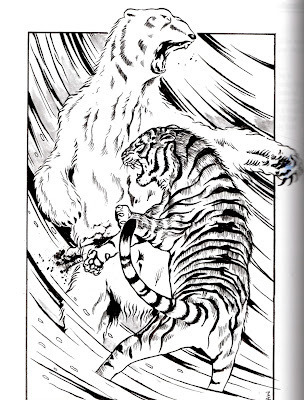
"Each chapter pairs contenders from various ecosystems and time periods, setting up 'fight to the kill' matches between the polar bear and Siberian tiger, prehistory's monstrous giant shark megalodon and a comparably formidable marine reptile of pliosaurian persuasion, the sperm whale and the giant squid, and so forth. Nick's vivid accounts of how he would expect these titanic slugfests to shape out make exciting reading, but what enhances his coverage immeasurably is the painstaking degree of factual research and provision of background pre- and post-fight information that he also provides.
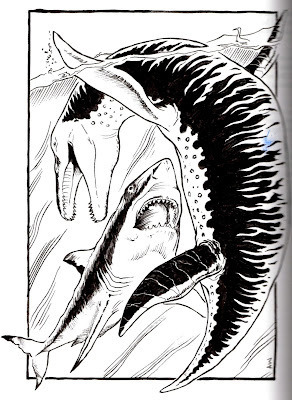
"Moreover, whereas a welter of facts and figures might in the wrong hands be off-putting and even counterproductive to retaining the reader's interest, thanks to Nick's deft, infectiously enthusiastic style of writing, laced throughout with scintillating flashes of dry humour, the very substantial body of data that he incorporates into each chapter actually serves to engage interest even further. The net result is a book that is near-impossible to put down once you have begun reading it – after initially planning to read just the first chapter to begin with, simply to gain a feel for its style and depth before reading further, I found myself reading the entire manuscript from cover to cover at a single sitting, and enjoying every page of it immensely. Adding even further to my pleasure were its spectacular illustrations by Anthony Wallis [reproduced here in this present ShukerNature blog post], which bring these mighty antagonists so vividly to life.
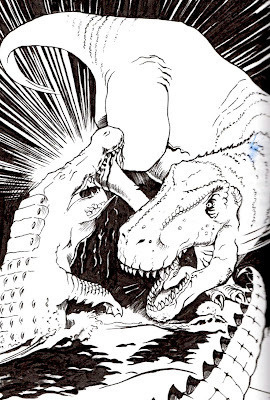
"So if you've ever wondered who would emerge victorious should a great white shark and a killer whale clash lethally in the high seas, or if T. rex and a primeval mega-croc experienced a truly fatal encounter, or if Komodo's veritable dragon should somehow find itself assailing an anaconda of Pythonesque proportions, prepare for all of your questions – and many others that you hadn't even got around to posing – to be answered within the pages of this superb book, where the gladiators of past and present, land and sea are only awaiting your private audience before commencing their deadly duels.
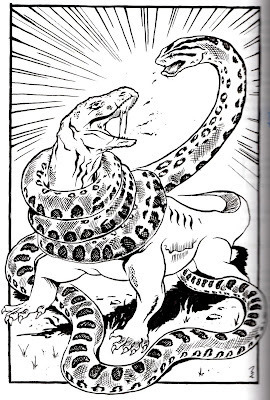
"After all, who needs boxing and wrestling, or even cage fighting, when the greatest and most bloodthirsty marauders ever to stride this planet – like the bona fide colossi that they are, were, and remain – are ready to perform at your personal behest? So take your seat ringside, and don't forget your popcorn!"
Predator Deathmatch is available from Amazon.com (click here ), and from Amazon.co.uk (click here ).

Published on February 16, 2012 23:40
February 14, 2012
BEWARE OF THE CATIPOCE - THE CHESHIRE CAT'S PREFABULOUS COUSIN!
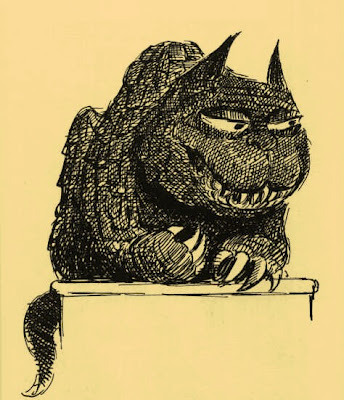 The dreaded Catipoce, as illustrated by Edward Ardizzone in James Reeves's Prefabulous Animiles (1957)
The dreaded Catipoce, as illustrated by Edward Ardizzone in James Reeves's Prefabulous Animiles (1957)The Cheshire Cat, from Lewis Carroll's classic children's book Alice's Adventures in Wonderland (1865), may well be the literary world's most famous grinning felid - but it isn't the only one...
One of the earliest books that beckoned me down the often-thorny, frequently-meandering, but ever-beguiling pathway of cryptozoology is one that may not be very familiar to many (if, indeed, any) other cryptozoologists - but it definitely should be. It was a thoroughly enchanting book of original poetry by James Reeves (and illustrations by Edward Ardizzone), first published in 1957, and entitled Prefabulous Animiles.
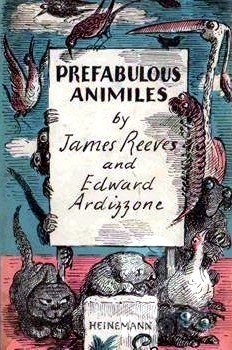 Prefabulous Animiles (William Heinemann Ltd: London, 1957); the Catipoce is depicted at bottom left on the front cover
Prefabulous Animiles (William Heinemann Ltd: London, 1957); the Catipoce is depicted at bottom left on the front coverAs its title suggests, it was filled with captivating verses on such wonderfully whimsically albeit totally fictitious monsters as the hippocrump, the chickamungus, the doze, and - my own personal favourite (evincing even at that tender age a particular interest in mystery cats) - the catipoce.
As revealed in a hilarious eight-verse poem, this was a fiendish female Cheshire cat doppelgänger that lured her hapless victims within reach of her lethal carrion-stained claws and 44 crooked teeth by virtue of her mesmerising, irresistible grin. Having said that, so ghastly is this sight that many have gone mad at the merest glimpse of it – always assuming that they haven't already succumbed to her fatal sneeze!
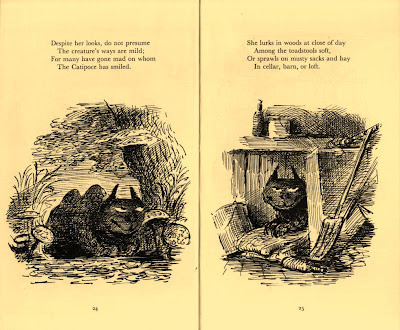 Beware of the Catipoce! Two pages from her poem in Prefabulous Animiles, illustrated by Edward Ardizzone
Beware of the Catipoce! Two pages from her poem in Prefabulous Animiles, illustrated by Edward ArdizzoneLurking at dusk in woods, cellars, barns, or even an uninspected loft, or crouched behind neglected rubbish dumps, sometimes only the catipoce's horn-humped back is visible – until some unwary person treads close enough to witness this foul felid's rapacious grin:
THE CATIPOCE - by James Reeves
'O Harry, Harry! hold me close -
I fear some animile.
It is the horny Catipoce
With her outrageous smile!'
Thus spoke the maiden in alarm;
She had good cause to fear:
The Catipoce can do great harm,
If any come too near.
Despite her looks, do not presume
The creature's ways are mild;
For many have gone mad on whom
The Catipoce has smiled.
She lurks in woods at close of day
Among the toadstools soft,
Or sprawls on musty sacks and hay
In cellar, barn, or loft.
Behind neglected rubbish-dumps
At dusk your blood will freeze
Only to glimpse her horny humps
And hear her fatal sneeze.
Run, run! adventurous boy or girl -
Run home, and do not pause
To feel her breath around you curl,
And tempt her carrion claws.
Avoid her face; for underneath
That gentle, fond grimace
Lie four-and-forty crooked teeth -
My dears, avoid her face!
'O Harry, Harry! hold me close,
And hold me close a while;
It is the odious Catipoce
With her devouring smile!'
Lewis Carroll's Cheshire Cat has a lot to answer for!
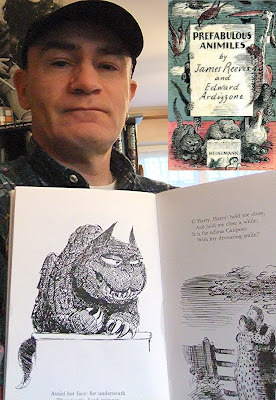 Showing Edward Ardizzone's marvellous Catipoce illustration in my much-treasured copy of James Reeves's delightful book Prefabulous Animiles (Dr Karl Shuker)
Showing Edward Ardizzone's marvellous Catipoce illustration in my much-treasured copy of James Reeves's delightful book Prefabulous Animiles (Dr Karl Shuker)
Published on February 14, 2012 22:52
February 13, 2012
IN THE PINK WITH AMERICA'S GIANT CRYPTO-SALAMANDERS
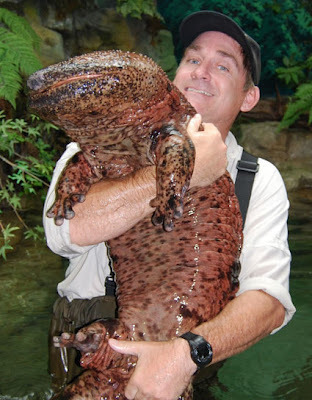
After posting the above photograph of a Chinese giant salamander Andrias davidianus on my Facebook wall a few days ago, it attracted such interest and such a variety of comments, including some on the subject of alleged giant mystery salamanders reported in North America, that it reminded me of the section on this very same subject that I had included in my book In Search of Prehistoric Survivors back in 1995. Consequently, for those of you who may not have seen it, I am reprinting that section here (with a few slight amendments), plus some new illustrations and a brief update.
A 'DINOSAUR' CALLED PINKY
If there are any regions in North America with prospects (however slim) for concealing living dinosaurs, they must include the humid swamplands of Florida - especially as a creature reputedly akin to such animals has been reported from here on several different occasions.
On 10 May 1975, an outboard motor boat transporting five people on a fishing trip along Florida's 300-mile-long St Johns River experienced a close encounter at a spot between Jacksonville and the Atlantic Ocean with something very peculiar - and certainly not pretty - in pink! At around 10 am, one of the passengers, Brenda Langley, saw the head and neck of an extraordinary creature surface a mere 20 ft from their vessel, and shortly afterwards it was also spied by the other four passengers when they turned the boat around - to escape what seemed to be an oncoming storm, heralded by the arrival of some dark clouds.
According to subsequent press reports of their encounter, quoted by mystery beast chronicler Mark A. Hall in Wonders (December 1992), Dorothy Abram likened it to "...a dinosaur with its skin pulled back so all the bones were showing...[and] pink. Sort of the color of boiled shrimp". She also noted that its head was at least the size of a man's, with a pair of snail-like horns bearing knob-like structures at their tips, there were flaps reminiscent of gills or fins hanging down from the sides of its head, its mouth turned downwards, its large eyes were dark and slanted, and its neck had protruded about 3 ft out of the water, revealing a seemingly serrated upper surface. Brenda Langley agreed with this description, and added that it was an ugly creature recalling pictures of dragons. Its behavioural activity had seemed to its eyewitnesses be one of inquisitiveness, returning their intrigued stares with an equal extent of keen observation during its 8-second appearance - after which it submerged so effortlessly that it did not even leave behind a ripple.
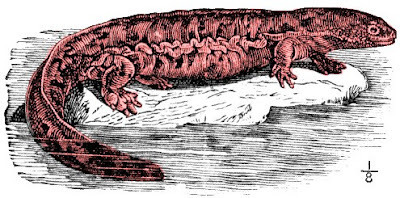 Pinky, as based upon a hypothetical pink hellbender (see later)
Pinky, as based upon a hypothetical pink hellbender (see later)Soon to receive the inevitable nickname of Pinky, the St Johns River water beast attracted sufficient media interest to elicit accounts from several other people claiming sightings of just such a beast in this same area as far back as the mid-1950s. This, of course, is hardly an uncommon feature of cryptozoological cases receiving media exposure.
However, Mark Hall has good reason for believing in the validity of these earlier Pinky reports - because 20 years before the encounter of May 1975, he had seen newspaper accounts from various Jacksonville papers that described sightings of a similar creature and which themselves dated back a number of years.
Moreover, Hall discovered from an Argosy article written by cryptozoologist Ivan T. Sanderson that during the 1960s, while bow-hunting along the St Johns River, biology student Mary Lou Richardson, her father, and a friend had all seen a very peculiar animal with a great flat head, a rather small neck, and (in Sanderson's own opinion) the overall appearance of a donkey-sized dinosaur. Four other groups of tourists independently saw it during that same day, and enquiries revealed that this animal was well known to local fishermen and hunters. In short, Pinky was far from being the cryptozoological newcomer that it had initially seemed.
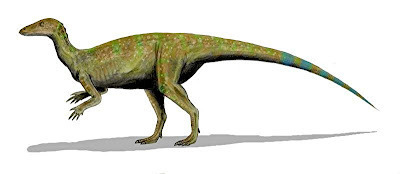 Reconstruction of Thescelosaurus (Nobu Tamura/Wikipedia)
Reconstruction of Thescelosaurus (Nobu Tamura/Wikipedia)Taking his lead from Sanderson's view, Hall has very tentatively sought to reconcile the perplexing Pinky with an undiscovered, living species of hypsilophodontid dinosaur called Thescelosaurus - an 11-ft-long bipedal dinosaur the size of a small car, with five fingers on each hand and five toes per foot, a long stiff tail, and characterised by rows of bony studs set in the skin along its back that may have given it a somewhat uneven, serrated appearance. One of the last known dinosaurs, it lived during the very late Cretaceous of western North America, and was related to the larger, more familiar Iguanodon.
Personally, I very much doubt that we need nominate anything as dramatic as a living dinosaur when seeking to unveil Pinky's identity - at least not until we have surveyed reports describing prominently pink mystery beasts of a herpetological persuasion from elsewhere in the U.S.A., for such beasts have been recorded far beyond the St Johns River of Florida.
HORNS AND HELLBENDERS
Two centuries ago, for example, strange creatures referred to loosely as giant pink lizards were frequently reported from southcentral Ohio's Scippo Creek by the first white settlers here. Hall's book Natural Mysteries (1991) presents a detailed investigation of these animals, concluding that they could well be the larval form of some undiscovered giant amphibian.
They were said to be at least 3 ft long but generally averaged 6-7 ft, were invariably pink in colour, sported large horns ("like a moose", according to one very startled eyewitness, a young carpenter), and were always associated with water. When their habitat suffered a great drought some time before 1820 that dried out many streams and wells, and suffered additional devastation via a terrible fire, the outcome was their extinction. If we equate these animals' 'horns' with prominent, branching external gills, rather like those of the much smaller axolotl of Mexico, these 'pink lizards' could indeed have been larval salamanders - but their size far exceeds any known species in North America, or anywhere else.
Nature writer Herbert Sass was a much more recent observer of a pink mystery beast in North America. While boating in or around 1928 with his wife Marion on Goose Creek lagoon, near Charleston, Sass saw something moving under the water, and when he succeeded in lifting part of its heavy bulk up out of the water on an oar they saw that it was bright salmon-pink and orange in colour, as thick as a man's lower thigh, with a smooth tail, and a pair of short legs like those of an alligator or salamander. Within moments, however, their mysterious captive had slipped off the oar, and back into the water. A 2-ft-long portion of a large worm-like beast of similar colouration to Sass's creature was briefly spied by Ivan Sanderson and his wife Sabina during the early 1970s, amid the dense water vegetation in a pond created from an artificial swamp on their farm at Warren County, New Jersey.
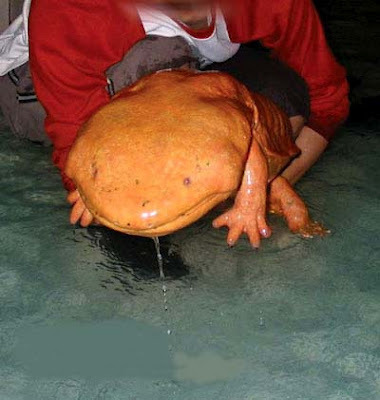 An orange-coloured specimen of the Chinese giant salamander
An orange-coloured specimen of the Chinese giant salamanderSpeculation concerning the existence in North America of giant salamanders might seem just as risky as speculation regarding the presence here of living dinosaurs - were it not for the indisputable fact that the United States is already known to harbour one species of giant salamander - the euphoniously-named hellbender Cryptobranchus alleganiensis. Up to 29 in long, it is most closely related to a pair of even larger species, native to Asia's Far East - the Japanese giant salamander Andrias (=Megalobatrachus) japonicus (up to 5 ft long), and the Chinese A. davidianus (up to 6 ft long, and the world's biggest salamander).
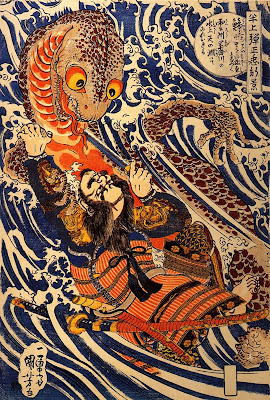 The samurai Hanagami Danjo no jo Arakage in Izumo stabbing a giant salamander, by Utagawa Kuniyoshi
The samurai Hanagami Danjo no jo Arakage in Izumo stabbing a giant salamander, by Utagawa KuniyoshiIt is interesting to note that in his own report of his sighting, Sass described the creature that he briefly captured as a kind of giant hellbender, at least 5-6 ft long, because this grotesque species is also reminiscent of Pinky from Florida's St Johns River. Just like Pinky, the hellbender has a large flattened head, a long downward-curving mouth, loose folds of skin on its neck, and wrinkles along much of its body that could conceivably be mistaken for protruding bones during as brief a sighting as that of 10 May 1975. Moreover, the hellbender does indeed inhabit fast-flowing streams and rivers, and even in their well-aerated water it must still surface to gulp air every so often, because unlike various other salamanders it does not have external gills as an adult. And with a lifespan for this species of at least 30 years, a single specimen could have been responsible not only for the Pinky sighting of May 1975 but also for those predating it by more than 20 years.
Even its dissimilarities are not irreconcilable. Although the hellbender's official distribution range is from the Great Lakes through the eastern United States to Georgia and Louisiana, it would not be impossible for a population to remain undetected amid the little-traversed Florida swamplands. Interestingly, the concept of out-of-place giant salamanders has at least two notable if somewhat controversial precedents.
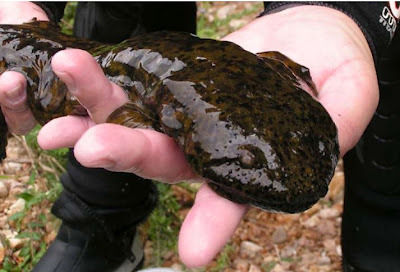 The hellbender
The hellbenderIn or around 1939, a 25-30-in-long Andrias salamander was captured by a commercial fisherman in California's Sacramento River. Maintained alive for a time within a wooden trough suspended in the fisherman's own bathtub, it was examined by Stanford University herpetologist Dr George S. Myers, who felt that it differed in colouration from both of the two known modern-day species of Andrias. Thus, he speculated that although it could simply be an escapee from captivity, it may represent an unknown, native New World species - i.e. a relic from prehistoric times, when the zoogeographical range of the giant salamanders was much greater than its fragmented modern-day equivalent.
This latter identity, however, was challenged by Chico State College herpetologist Dr Thomas L. Rodgers, who announced that he too had inspected the Sacramento giant salamander, but had later learnt that it was in reality an absconded Chinese giant salamander called Benny - one of three A. davidianus specimens purchased by fish fancier Wong Hong somewhere in China. According to Charles Bjork, captain of the steamer Isleton, Benny had escaped while being transported through the straits on the way to Stockton Harbour. Even so, this does not explain the sighting of what was described by eyewitnesses as the "head of a gigantic lizard" emerging from the Sacramento River - in 1891.
 19th-Century engraving of a Japanese giant salamander viewed underwater
19th-Century engraving of a Japanese giant salamander viewed underwaterNor can it counter the longstanding belief that a deep lake in California's Trinity Alps is home to giant salamanders 5-9 ft long. Attorney Frank L. Griffith claimed to have spied five of them and even to have hooked one in the 1920s - due to its great size, however, he was unable to haul it out of the water. His story attracted Dr Rodgers's interest, who visited the lake four times hoping to see these beasts. Despite denouncing Myers's idea regarding the Sacramento specimen, he speculated that they may be a relict population of Andrias, but all that he found were some Dicamptodon salamanders - none more than 1 ft long.
Other searches have taken place since then, whose participants included in 1960 the Texan millionaire Tom Slick, a keen amateur cryptozoological investigator, but as no specimen of Andrias or the hellbender has so far been found here, the case for their existence remains unproven. Yet in view of its secretive, principally nocturnal lifestyle, it would not be too surprising for populations of hellbenders outside the species' known distribution range to have escaped detection, especially in little-explored swamps or high mountain lakes.
The extra-large size of some of North America's unidentified salamander-like beasts (pink or otherwise) is not a problem either, when seeking to identify them as hellbenders. Although the largest recorded specimens are under 3 ft, formerly there may have been much larger ones, whose greater size rendered them up as targets for early Western settlers eager to test their shooting capabilities upon these inoffensive, sluggish beasts. Record-size specimens of many different species have elicited similar attention from hunters in the past, the systematic killing of such specimens bringing about an eventual decrease in their species' average size (the gradual reduction in average total length of the much-hunted European giant catfish or wels Silurus glanis over the past century exemplifies this trend). In remote areas little-frequented by man, however, some reclusive giant specimens could still thrive, undisturbed.
Even the distinctive pink colour of most of the strange creatures reported here does not oppose a hellbender identity. Albinism is not uncommon among salamanders, and albinistic specimens normally exhibit a pink sheen due to the presence of blood coursing through their blood vessels beneath the outer skin layer. In the hellbender, the skin's supply of blood vessels is particularly pronounced - this extensive vascularisation enables the animal to obtain much of its oxygen requirements by direct absorption through its skin from the surrounding water of its aquatic domain. Hence an albinistic hellbender would be conspicuously pink. And because the genetics of albinism in salamanders (as in many other animals) are such that albino salamanders can only yield more albinos, all-pink populations would rapidly arise.
 An unequivocally pink-coloured Chinese giant salamander (Zoological Society of London)
An unequivocally pink-coloured Chinese giant salamander (Zoological Society of London)In contrast, Mark Hall mentioned that the pink colour of these mystery beasts could be due to their diet, as with the pink plumage of flamingos. This latter situation, however, is a very specific one, and there is no evidence to suggest that a similar phenomenon occurs in salamanders - whereas pet albino (and also leucistic) axolotls, for example, are often fed upon bright-red tubifex worms and various pink crustaceans, they never acquire the pigmentation of their prey.
Overall, therefore, a hellbender identity for the pink mystery beasts is the most satisfactory explanation available. Even so, there is still the matter of the Scippo Creek beasts' bizarre moose-like horns to resolve, because hellbenders have no such structures - when adult, even their gills are internal. Consequently, if the Scippo creatures' 'horns' are actually large external gills these animals would much more closely resemble a giant form of axolotl Ambystoma mexicanum - the best-known of the Mexican neotenic forms belonging to the tiger salamander complex.
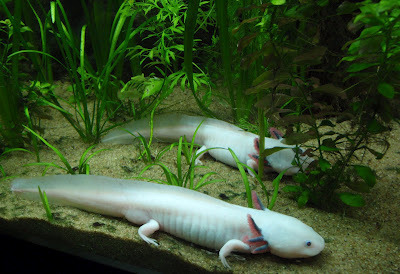 Leucistic axolotls (as confirmed by their dark eyes) at Vancouver Aquarium (ZeWrestler/Wikipedia)
Leucistic axolotls (as confirmed by their dark eyes) at Vancouver Aquarium (ZeWrestler/Wikipedia)Under standard conditions, most salamanders metamorphose normally from the gilled larval salamander into the true adult, reproductive form. In the case of the axolotl, however, and especially if the pools in which it thrives are low in iodine, this metamorphosis is often halted, and the animal retains its larval form throughout its life, but nonetheless acquires the capability to reproduce and is thus said to be neotenic.
A neotenic, extra-large version of the hellbender might thus explain the pink mystery beasts of Scippo, but no such specimens have so far been formally documented. Moreover, not only are neotenic salamanders exclusively aquatic, but if they are lifted out of the water their gills flatten against their neck, thereby relinquishing their antler-like form.
And in any case, what of Pinky - with its very different, snail-like horns, and noticeably large eyes? Hellbenders have no such horns, and their eyes are very small. Could Pinky's horns be breathing tubes? If so, a hellbender with snorkels and protruding eyes is clearly taxonomically separate from the known species - so although a thriving Thescelosaurus dinosaur abroad in North America remains highly unlikely, the possibility of an unknown species of giant salamander lurking amid its vast swamplands may be worth further investigation.
UPDATE
Since writing the above section in 1995, I have encountered a number of photographs, such as those included here, which confirm that pink giant salamanders can and do exist. True, these are of the Chinese species (which, as Dr Darren Naish noted here in a Tetrapod Zoology post for 3 December 2010 on these amphibians, is more variable morphologically than is often realised), but their existence substantiates the likelihood that pink hellbenders, for the reasons already presented here, could also arise.
Moreover, American cryptozoologist Dale Drinnon has lately speculated that perhaps an unknown, giant form of one of North America's mudpuppies or waterdogs Necturus spp. may be responsible for some of the reports documented here. True, unlike the hellbender mudpuppies retain their external gills into adulthood as a normal occurrence, but these wholly aquatic salamanders are less than 1.5 ft long, so a giant form would require a proportionately greater increase in size than would be true for the hellbender.
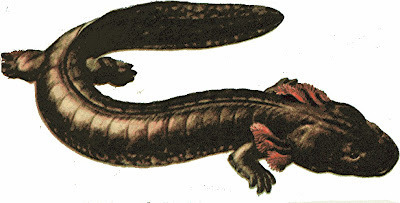 A mudpuppy, showing its external gills
A mudpuppy, showing its external gillsIn 2008, veteran American cryptozoologist Loren Coleman conducted a search for Pinky in and around Florida's St Johns River, details concerning which can be found here.
Published on February 13, 2012 12:08
February 12, 2012
THE ENCYCLOPAEDIA OF NEW AND REDISCOVERED ANIMALS - FEATURED IN THE GUARDIAN
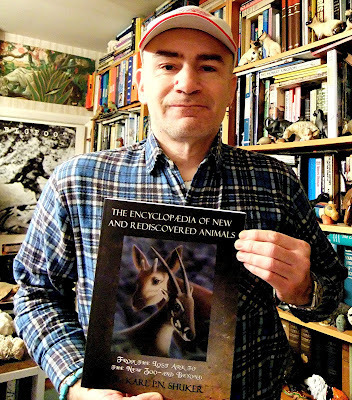 The proud father with his latest progeny! (Dr Karl Shuker)
The proud father with his latest progeny! (Dr Karl Shuker)It's always encouraging to learn that one of your books has made the pages of a leading newspaper.
So I'm very pleased to discover that my latest book, The Encyclopaedia of New and Rediscovered Animals (Coachwhip Publications: Landisville, 2012), has appeared today in London's Guardian newspaper, as one of the titles featured in Ian Paulsen's long-running 'Birdbooker Report' book reviews column (today's was #209).
Check it out here:
http://www.guardian.co.uk/science/grrlscientist/2012/feb/12/1
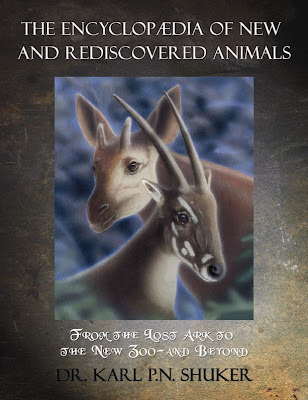
Published on February 12, 2012 20:25
February 2, 2012
THE CRYPTIC KROW - MYSTERY REPTILE, BUT BURGLAR'S FRIEND!
 Mr Nice – the bestselling autobiography of Howard Marks
Mr Nice – the bestselling autobiography of Howard MarksI've said it many times before, but it still bears repeating – reports of mysterious animals can turn up in the most unexpected places. For example: you're hardly likely to discover a report of an extraordinary, unidentified reptile in the autobiography of a major convicted drug smuggler, right? Wrong!
First published in 1996 but soon becoming a runaway international bestseller that has since been reprinted many times, Mr Nice is the autobiography of Howard Marks (its title referring to 'Donald Nice', one of Marks's numerous pseudonyms), whose eventful criminal history is described as follows on the back cover of the 1998 paperback edition published by Vintage:
"During the mid 1980s Howard Marks had forty-three aliases, eighty-nine phone lines and owned twenty-five companies trading throughout the world. At the height of his career he was smuggling consignments of up to thirty tons of marijuana, and had contact with organisations as diverse as MI6, the CIA, the IRA and the Mafia. Following a worldwide operation by the Drug Enforcement Agency, he was busted and sentenced to twenty-five years in prison at Terre Haute Penitentiary, Indiana. He was released in April 1995 after serving seven years of his sentence."
 Poster for the 2010 biopic 'Mr Nice', starring Rhys Ifans as Howard Marks
Poster for the 2010 biopic 'Mr Nice', starring Rhys Ifans as Howard MarksTucked away amid Marks's recollections of his memorable life of crime, however, is a fascinating but highly unexpected snippet of cryptozoological interest, which reads as follows:
"I had been advised by Raoul to visit Murray Hill Station [in Pakistan] on the borders of Kashmir, a few hours' drive from Islamabad. Foreigners were not allowed to rent cars, so I made a private arrangement with a local taxi-driver who spoke a little English. We were driving on poor roads through the foothills of the Himalayas. I saw and smelt fields of marijuana. A large, five-foot-long, prehistoric-looking lizard ambled across the road in front of us and disappeared into a marijuana bush. The taxi screamed to a halt, and the driver pointed and yelled, 'Krow! Krow!'
"'What is it?' I asked.
"'It is Krow, Mr Nice, burglar best friend.'
"'I don't understand.'
"'You want to come to my brother cousin, Mr Nice? I will show you.'
"'Yes, please,' I said, well in the mood for arbitrary adventures with burglars' friends and brother cousins.
"We took a track off the road, drove for miles, and stopped outside an old, meandering group of dusty yellow buildings. An old man dressed in colourful rags came out through a hole in the wall and grunted at the taxi-driver.
"'This is Mohammed, Mr Nice. He is pleased to meet you, Mr Nice.'
"The two babbled away in some unknown tongue and beckoned me into a walled courtyard full of Krows of all sizes. At a signal from Mohammed, one of the Pakistani workers caught hold of a large Krow by its tail, body-slammed it against the high wall, and let go. The Krow stuck to the wall. The Pakistani climbed up the vertical Krow as if it was a ladder. I could see why the Krow was the burglar's best friend but still found it hard to imagine housebreaking with a giant lizard...
"Back at the Holiday Inn, Islamabad, Raoul came round. He confirmed the existence and uses of the Krow."
How surreal is that?! But what could the Krow be?
Its ability to adhere so readily to walls immediately calls to mind the geckos, but there is certainly no known species of gecko that attains a length of 5 ft (the largest, a 'mere' 2 ft long, is Delcourt's giant gecko Hoplodactylus delcourti, known only from a single taxiderm specimen of probable New Zealand origin, and believed to be one and the same species as a reputedly mythical New Zealand lizard known to the Maori people as the kawekaweau).
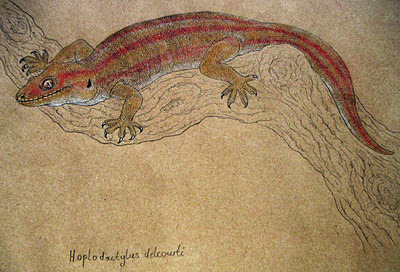 Delcourt's giant gecko (Markus Bühler)
Delcourt's giant gecko (Markus Bühler)Such dimensions are much more compatible with a species of monitor (varanid), but these lizards are not known for their wall-gripping abilities - and certainly not while someone is climbing all over them! Similarly, their nature is definitely not placid enough for anyone to risk doing this, even if such lizards could grip walls tightly enough to remain in place.
Is there anyone out there who can shed any light on this thoroughly perplexing herpetological mystery? If so, please send in details!
Oh, just one other thing: if by any chance you happen to own a large lizard as a pet, please don't try this at home!
Published on February 02, 2012 21:02
January 31, 2012
WHITE LIONS AND WHITE TIGERS - SEEKING A GENETIC IDENTITY
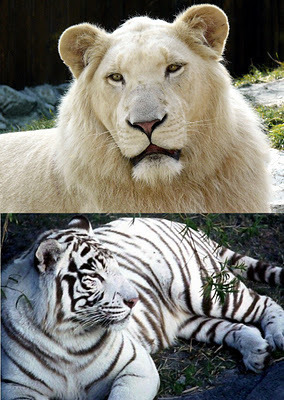 Leucistic white lion (Stano Novak-Wikipedia) and Rewa-type white tiger (Chris Brack)
Leucistic white lion (Stano Novak-Wikipedia) and Rewa-type white tiger (Chris Brack)"A white lion is magic, and if you see one, you should not say."
Opening words in the 1979 film 'The White Lions' (dir: Mel Stuart)
Native South African legends have long told of magical, elusive white lions inhabiting the Kruger National Park and the neighbouring Transvaal, and a few claimed sightings made by Western non-scientists were reported during the first half of the 20th Century. With no confirmed sightings by scientists, however, these leonine phantoms were not taken seriously by the zoological world – until 1977, that is, when zoologist Chris McBride announced to stunned press reporters across the globe that for the past two years, on a private game reserve called Timbavati adjacent to the Kruger, he had been studying and protecting three blue-eyed, snowy-white lions.
Tragically, as revealed in McBride's books The White Lions of Timbavati (1977) and Operation White Lion (1981), one of them, a female called Phuma, was subsequently shot by a poacher. As a result, the remaining two, Temba (male) and Tombi (female), together with their normal tawny-furred brother, Vela, were successfully captured and rehoused within South Africa's National Zoo in Pretoria for their own safety. Since then, many white lions have been bred from them and from others in captivity; there are currently around 300 individuals worldwide.
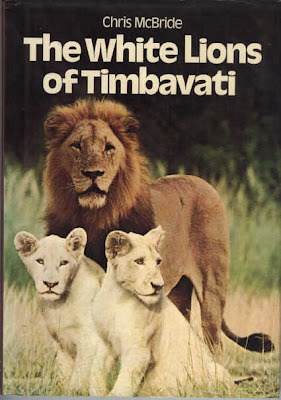
A white lion breeding programme is presently underway at Inkwenkwezi Private Game Reserve in South Africa's Eastern Cape province. In 2009, moreover, confirming that their coat colouration does not prevent them from hunting efficiently, an entire pride of captive-bred white lions was successfully introduced into the wild – the climax of a project initiated in 2003 by the Global White Lion Protection Trust (GWLPT), founded by author and conservationist Linda Tucker in 2002 (click here to visit the GWLPT's website).
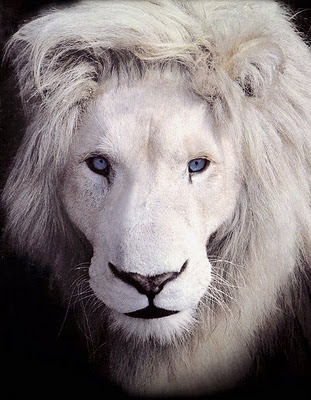 Blue-eyed Timbvati-type white lion, the focus of conservation efforts by the Global White Lion Protection Trust (Linda Tucker-Global White Lion Protection Trust)
Blue-eyed Timbvati-type white lion, the focus of conservation efforts by the Global White Lion Protection Trust (Linda Tucker-Global White Lion Protection Trust)A light-grey cub deemed (tentatively) to be a chinchilla specimen by felid geneticist Roy Robinson back in the 1980s had been born at Alabama's Birmingham Zoo in 1974. However, this individual was darker than the Timbavati trio.
Genetically, white lions are an intriguing phenomenon. Certain workers claim that some of these lions, including the original Timbavati trio, owe their white coat and blue eyes to the same genetic scenario as that which induces the chinchilla phenotype (coat appearance) in domestic cats. Moreover, they also offer this explanation for the blue-eyed white tigers of Rewa and many of those now in captivity worldwide (see later). But what is the genetic scenario responsible for the chinchilla phenotype in domestic cats?
Cat geneticists once thought that it was caused by a recessive albino allele (gene form) of the Full Colour gene, but this is no longer the case. Robinson's Cat Genetics for Breeders and Veterinarians (1999) is the most recent edition of Cat Genetics for Breeders, authored by the late Roy Robinson. One of the world's leading experts on this subject, Roy very kindly acted as my own mentor in this field for several years via numerous telephone conversations and exchanges of letters following the publication of my book Mystery Cats of the World (1989) – which he referred to in a review of it as "One of the most fascinating books that I have read for many a long day" (Cats, 15 December 1989).
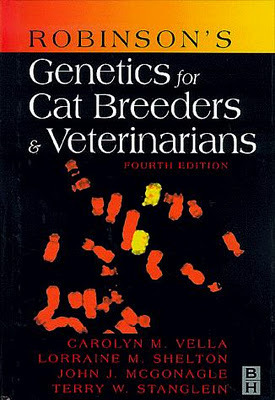
Robinson's Cat Genetics for Breeders and Veterinarians remains the internationally-recognised standard work on the genetics of domestic cats, and is the principal publication regarding this subject that I have utilised for reference purposes throughout this present ShukerNature post of mine. According to Roy's book, the chinchilla phenotype in domestic cats is nowadays deemed to be caused by the dominant inhibitor allele of the Inhibitor of Colour gene in combination with the dominant agouti allele of the Agouti gene:
"The dominant inhibitor gene I suppresses pigment fed into the growing hair. This results in the typical expression of white hairs with colored tips...That expression ranges from a barely perceptible white band at the base of the hairs next to the skin, to an almost completely white animal with the pigment restricted to the extreme hair tips...The smoke cat is the non-agouti [recessive, aaI-] expression...while the silver [i.e. the chinchilla] is the agouti [dominant, A-I-] form. The inhibitory qualities of the agouti protein increase the effect of this form of pigment inhibition – silver cats have more white undercoat than smokes."
Moreover, in his publications Roy Robinson considered that parallel variation in different species of cat was likely to be due to the presence of common genetic material, i.e. directly equivalent (homologous) mutant alleles at precisely the same positions (loci) on the chromosomes. As an example, Robinson considered that melanistic (all-black) individuals in as wide a range of species as the leopard, caracal, bobcat, leopard cat, serval, and tiger (but not the jaguar) may well all be due to the expression of precisely the same mutant allele - the recessive non-agouti allele of the Agouti gene A.
However, this presents a problem in relation to white big cats For whereas the inhibitor allele of the Inhibitor of Colour gene and the agouti allele of the Agouti gene, which are both present in chinchilla domestic cats, are both dominant, captive breeding programmes have confirmed that in white lions and also in white tigers, the white phenotype is inherited as a recessive trait.
True, there is a recessive allele of the Inhibitor of Colour gene, but this allele actually prevents inhibition of colour, resulting in golden-coated cats, not white ones.
So unless in lions and tigers the inhibitor allele is recessive, not dominant as in domestic cats, this genetic scenario (i.e. the recessive white phenotype in lions and tigers being due to the Inhibitor of Colour gene's dominant allele) remains an apparent contradiction.

A second possibility is that although in domestic cats the inheritance of the chinchilla phenotype does not involve the action of a recessive mutant allele of the Full Colour gene (as once believed), perhaps such an allele is responsible for the white phenotype in lions and tigers. This scenario would certainly explain the inheritance of the white phenotype as a recessive trait in these wild cat species.
Well worth noting here is the following thought-provoking statement (and, in particular, the final sentence in it) made by Roy Robinson noted in a Genetica paper from 1976:
"For many years it was believed that the silver and chinchilla breeds of cat were due to a mutant allele of the albino locus [i.e. the Full Colour gene C]...However, recent work has shown that the phenotype is a mimic of the typical chinchillated animal and is due to a dominant gene I, independent of the albino series...The gene inhibits the formation of pigment in the coat...No comparable form has yet been described for other Felids." [The change in typeface colour here is mine, for emphasis]
There, in that final line, may well be the key to this whole mystery. Could it be that there really is no Inhibitor of Colour gene in cat species other than the domestic cat, and that, instead, in wild cat species there genuinely is a recessive chinchilla albino mutant allele of the Full Colour gene that is responsible for the expression of the recessive homozygously-inherited white phenotype in tigers and lions?
A third possibility is that the white phenotype in these latter cat species is induced by a recessive allele of a gene separate from both the Inhibitor of Colour gene and the Full Colour gene.
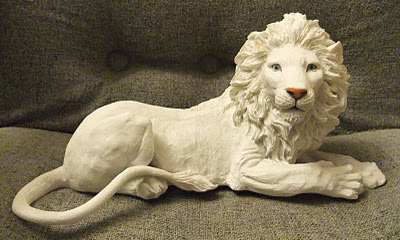 Model of a blue-eyed Timbavati white lion (Dr Karl Shuker)
Model of a blue-eyed Timbavati white lion (Dr Karl Shuker)Due to the immense amount of observations and studies documented in relation to domestic cat breeding, many of the various genes and their respective alleles responsible for coat phenotypes in this species have been conclusively identified and given specific names. In contrast, far fewer studies have been conducted in relation to the coat phenotypes of wild cat species, so there is far less confirmed information available concerning the specific identities of the genes and alleles involved with them.
As a result, the genetic terminology applied in relation to these latter genes and alleles in wild cat species is much looser – so much so, in fact, that the same name (e.g. 'inhibitor gene') is often applied to alleles of totally different genes if they happen to induce the same phenotype (even if one such allele is dominant and another is recessive), all of which only serves to confuse matters further.
Consequently, if anyone has scientifically-verified and published information concerning the precise genetic basis of white phenotype inheritance in lions or (tigers) that reconciles the apparent anomalies queried by me here, I would be very interested to receive full details.
LEUCISTIC LIONS
In contrast to the Timbavati-type lions, other white lions have normal eye colouration, and merely appear extremely pale, even blonde, versions of normal lions. This abnormally pale, even washed-out appearance has been reported from many other species too, and is known as leucism.
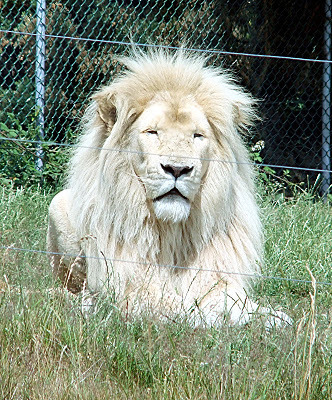 Leucistic white lion (Dr Karl Shuker)
Leucistic white lion (Dr Karl Shuker)Unlike albinism (with which it is often confused), in which only the production of dark pigment (eumelanin) is affected, leucism is caused by the failure during an animal's embryonic development of some or all of the actual pigment cells themselves to differentiate or to migrate properly from the neural crest (where they originate) to the skin, fur, scales, or feathers. And because all types of pigment cell differentiate from the same multi-potent precursor cell type, this means that leucism can cause the reduction of all types of pigment, not just one, resulting in the affected animal exhibiting a characteristic faded or washed-out appearance.
Yet even though leucism is popularly claimed to be the correct explanation for the type of pale lion with normal eye colour, pad colour, etc, documented here, I am presently unaware of any published cytological studies confirming this, i.e. by showing that such lions lack pigment cells rather than merely lacking pigment. The same applies in relation to white tigers, as these are also claimed by certain workers to be leucistic. Consequently, if anyone can provide me with references to such studies, I would very much like to receive them.
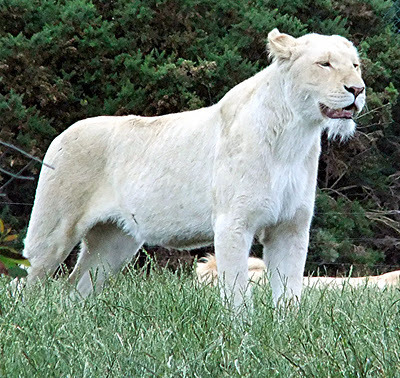 Leucistic white lioness (Dr Karl Shuker)
Leucistic white lioness (Dr Karl Shuker)Various non-leucistic explanations have also been proposed for these lions, but none has been verified to date. They include the action of a gene analogous if not homologous to the version inducing the champagne phenotype in horses; and the expression of the recessive dilute allele of the Dense Pigmentation gene in homozygous state modifying the action of the Red gene to yield the cream phenotype, as occurs in domestic cats.
I saw my first leucistic white lions in 2004, while staying at the Mirage Hotel during a holiday on The Strip in Las Vegas. In the grounds of the Mirage is 'The Secret Garden of Siegfried & Roy' – a wildlife park owned by these world-famous American stage magicians – where leucistic white lions, as well as white tigers and even a snow tiger (see later), are exhibited. Since then, moreover, I have seen specimens at a number of other locations around the world, where their pallid beauty never fails to fill me with awe.
 Visiting 'The Secret Garden of Siegfried & Roy' at the Mirage Hotel, Las Vegas (Dr Karl Shuker)
Visiting 'The Secret Garden of Siegfried & Roy' at the Mirage Hotel, Las Vegas (Dr Karl Shuker)WHITE TIGERS
One of the most evocative descriptions of a white tiger that I have ever seen appeared in a Wild About Animals magazine article from December 1989 dealing with white mutant animals:
The golden paint has been forgotten. Instead of fiery sun, we bathe in the cool moonlight of this wonderful creature. Nature's mistake is our magnificent gain.
Certainly, the sight of a sepia-striped, ivory-furred tiger, gazing into your eyes through its own twin orbs of glacial blue, is unforgettable - but what is the history of these ethereal creatures?
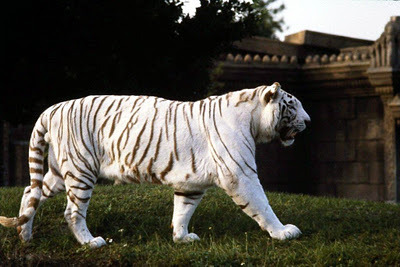 A white tiger – not burning bright but moonlight white (Chris Brack)
A white tiger – not burning bright but moonlight white (Chris Brack)White tigers originated as mutant Bengal tigers Panthera tigris tigris, and have been reported from many parts of India and its immediate neighbours (although there are even some reports from China and Korea), and appear to have existed for some considerable time. Indeed, the earliest known record dates back to 1561, when the Mogul emperor Akbar slayed a tigress that attacked his royal cavalcade near Gwalior. Two paintings dating from his reign and depicting this scene exist – appearing in his great work, Akbar Nama; one of these reveals that two of the tigress's cubs were white.
Similarly, the inhabitants of Assam have known of white tigers since time immemorial, and believe that anyone who kills one will certainly die himself soon after. Sadly, not everyone shares this conviction, and their striking appearance has inevitably made white tigers prime targets for big game hunters. In The Royal Natural History (1894-1896), Dr Richard Lydekker recorded a white tiger shot in Upper Assam during March 1889, and in 1891 one was reported from Poona. Pollock and Thom listed several white tigers in 1900 from Burma and the Jynteah hills of Meghalaya; and Indian wildlife researcher Dr E.P. Gee documented the sighting of two specimens (one of which was later shot) towards the onset of the 20th Century at an Assam tea estate - renamed Bogobagh ('White Tiger') tea estate afterwards.
Between 1907 and 1933, the Journal of the Bombay Natural History Society included no less than 17 reports of shot white tigers, including one in the Dhenkanal State, Orissa, in 1909; another during 1910 in the Bilaspur district of what was then called the Central Provinces; and two in the district of Bhagalpur in Bihar sometime around 1926. More were shot during the 1920s and 1930s, including 15 in Bihar alone! On 22 January 1939, a specimen was killed by the Nepalese prime minister at Barda camp in Terai Nepal.
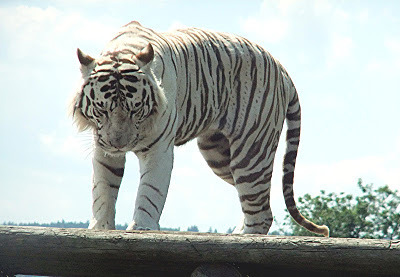 A white tiger (Dr Karl Shuker)
A white tiger (Dr Karl Shuker)Some time before World War I, several white tigers frequented the area of jungle where the districts of Mandla and Bilaspur border on Rewa. In December 1915, one of these (a two-year-old male) was captured near Sohagpur, by the Maharajah Gulab Singh of Rewa. He exhibited it at his summer palace for the next five years, until its death, whereupon it was stuffed and presented to King George V. During later years, eight white tigers were shot in the Rewa forests, the last of which, a male, was bagged by the new Maharajah in 1947.
Disturbingly (though not unexpectedly, in view of such deplorable depletion), sightings of white tigers in the wild within more recent times have been few and far between. Indeed, the last confirmed individual on record appears to have been spied (and, yet again, shot!) in 1958 near Hazaribagh, Bihar, and its skin was displayed at a Calcutta taxidermist's shop. Fortunately, however, not all white tigers shared this tragic fate, and it is the history of one of these lucky few that explains why white tigers still exist today.
Russian porcelain figures of white tigers (Dr Karl Shuker)
On 27 May 1951, a male white tiger was captured alive in Rewa, and was housed within the now-disused summer palace of the Maharajah. This specimen was the famous Mohan, sire of the pure strain of white Bengal tigers subsequently exhibited in zoos ands circuses all over the world. Mohan was mated with many different tigers, all normal-coloured at first, from which only normal-coloured offspring were produced. However, when one of these was itself mated with Mohan, white tiger cubs were at last obtained, and the strain has thrived ever since, with new tigers introduced intermittently in order to strengthen and perpetuate the line. (Moreover, white tigers have also appeared spontaneously in other captive tiger lineages elsewhere, showing that the genetic basis for white tigers is more widely distributed through the world tiger population than once assumed.)
This captive-breeding programme was studied in depth by Hong Kong University zoologists Drs Ian W.B. Thornton and K.K. Yeung, together with Dr K.S. Sankhala from Delhi Zoological Park, and in 1967 the trio published a Journal of Zoology paper. In it, they proposed that the white tiger form was caused by a recessive mutant allele when present homozygously (i.e. represented by two copies, as opposed to just one, or none at all). Further studies by Thornton (by then residing at La Trobe University in Victoria, Australia) into the inheritance of the white phenotype (coat appearance) in tigers confirmed this (Journal of Zoology, 1978).
 Seen Siegfried and Roy's white tigers, bought the t-shirt! (Dr Karl Shuker)
Seen Siegfried and Roy's white tigers, bought the t-shirt! (Dr Karl Shuker)As discussed earlier here regarding the genetics of white lions, it was once thought that a certain recessive mutant albino allele of the Full Colour gene was responsible for the chinchilla phenotype in domestic cats and, by extension, white tigers and lions. However, cat geneticists later discovered that in domestic cats it is the combined effect of the dominant agouti allele of the Agouti gene and the dominant inhibitor allele of the Inhibitor of Colour gene that is responsible for the chinchilla phenotype. They achieve this by so significantly inhibiting the production of the yellow pigment phaeomelanin, normally present in pigment bands on the hairs of the cats' undercoat, that the hairs' shafts are entirely silver or white - only their very tips are pigmented. Moreover, some workers claim that this same genetic scenario is responsible for the white phenotype in tigers too, but this raises a query.
Thornton's studies had verified that white tigers mated with white tigers can only produce white tigers, whereas normal tigers mated with normal tigers usually produce only normal tigers but can occasionally produce white tigers too. Consequently, it is clear that whichever allele is responsible for white tigers, it is both homozygous and recessive. Consequently, the white phenotype in tigers is inherited as a recessive trait. How, therefore, can the combination of the dominant inhibitor allele of the Inhibitor of Colour gene and the dominant agouti allele of the Agouti gene, responsible for the dominant chinchilla phenotype in domestic cats, also be responsible for the recessive white phenotype in tigers?
As previously noted here regarding the same genetic conundrum with white lions, three different possibilities come to mind:
1) Could it be that in tigers the inhibitor allele of the Inhibitor of Colour gene is recessive, not dominant?
Worth noting is that in domestic cats there is a recessive allele of the Inhibitor of Colour gene. However, this allele actually prevents the inhibition of pigment, resulting instead in golden-furred individuals (discussed a little later here), not white ones.
2) Although in domestic cats the chinchilla phenotype is not induced by a recessive mutant allele of the Full Colour gene (as once believed), perhaps such an allele (or an analogous one) is responsible for the white phenotype in tigers. This would explain the inheritance of the white phenotype as a recessive trait in tigers.
3) Maybe the white phenotype in tigers is due to a recessive allele of a gene distinct from both the Inhibitor of Colour gene and the Full Colour gene.
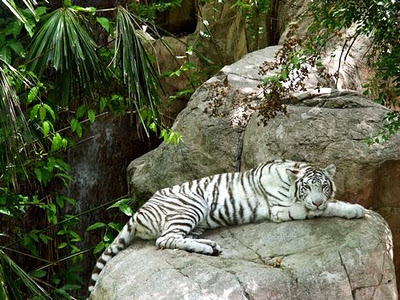 White tiger
White tigerAs discussed earlier, a major problem when investigating the likely genetic scenarios of coat phenotypes in wild cat species is that far fewer studies have been conducted upon such felids than is the case with the domestic cat. This has resulted in the usage of some very loose, non-precise genetic terminology in relation to wild cats – to the extent that totally separate alleles or genes that happen to induce the same phenotype (regardless of whether they are recessive or dominant) are often referred to by the same general name (e.g. 'inhibitor gene'), which obviously can – and does - cause confusion. In contrast, the genetics of the domestic cat has been studied so intensely that many of the alleles and genes responsible for coat phenotype and their respective chromosomal loci have been precisely identified, enabling a series of precise, universally-agreed genetic names to be applied.
In their papers on white tiger genetics, Thornton and colleagues refrained from referring to the recessive allele responsible for the white phenotype as an Inhibitor of Colour allele, a Full Colour allele, or, indeed, an allele of any named gene. Instead, they merely labelled it as w and recessive, and labelled the allele responsible for the wild-type phenotype as W and dominant – which was certainly the wisest, most satisfactory decision in the absence of confirmed data as to which specific locus this recessive allele's gene occupies.
If anyone has scientifically-verified information concerning the precise identity of the allele(s) responsible for white phenotype inheritance in tigers (or lions), and which reconciles the apparent anomalies queried by me here, I would be very interested to receive full details and references to the relevant published scientific papers.
Interestingly, there is a recessive mutant allele of the Full Colour gene that does produce blue-eyed albinos in domestic cats. However, the coat of such animals is entirely white, with no dark markings of any kind. Hence this allele cannot be responsible for white tigers, as their coat is patterned with black, grey, or brown stripes. Equally, the Dominant White gene, responsible for many blue-eyed white domestic cats, cannot be responsible for white tigers (or lions), because, as its name suggests, genetically it is dominant, not recessive.
Muddying the waters even further, some workers refer to white tigers as leucistic. Yet leucism is a wholly separate condition from any of the scenarios considered above, because it involves not merely the absence of pigment but the absence of pigment cells (see earlier).
Irrespective of its genetic or cytological origin, however, the white tiger's beauty is marred by the accompanying presence of certain undesirable afflictions. Most notable of these is a congenital abnormality of the central visual pathway. Some of the optic nerve fibres connect up with the wrong side of the brain - a condition that can be associated with cross-eyes (strabismus).
SNOW TIGERS, PINK-EYED ALBINO TIGERS, AND GOLDEN TABBY TIGERS
Typical white tigers possess narrow, but clearly discernible brown, black, or grey stripes, but very occasionally a specimen has been born that totally or virtually lacks any degree of striping. These white stripeless tigers are popularly referred to as snow tigers, of which perhaps the most famous examples are the magnificent individuals owned by American stage magicians Siegfried and Roy. They own a number of white tigers too, as well as white lions, which can be seen on display in their private wildlife park, 'The Secret Garden of Siegfried & Roy', at the Mirage Hotel in Las Vegas. While staying at the Mirage during my 2004 holiday on the Strip, I was able to see these exotic big cats personally.
 Alongside a startlingly-realistic life-sized cut-out of Siegfried & Roy with one of their snow tigers at The Mirage Hotel, Las Vegas (Dr Karl Shuker)
Alongside a startlingly-realistic life-sized cut-out of Siegfried & Roy with one of their snow tigers at The Mirage Hotel, Las Vegas (Dr Karl Shuker)Other notable snow tigers exhibited in captivity include various specimens at Cincinnati Zoo (the first zoo, back in the 1980s, to have such animals; two cubs born at Liberec Zoo in the Czech Republic during the 1990s; and Artico, born in May 2004 to normal tiger parents at a wildlife refuge in Alicante, Spain.
 A rare snow tiger, in which body markings are scarcely visible (Alan Pringle)
A rare snow tiger, in which body markings are scarcely visible (Alan Pringle)Genetically, a snow tiger probably exhibit the same genetic make-up for coat colouration displayed by white tigers but some investigators have speculated that it may additionally possess a gene that has been dubbed the Wide Band gene. This latter allele reputedly doubles the width of the yellow band of pigment on the hair shafts of the white tiger's fur. As most of its fur is already white, such an allele would have no visible effect – except, that is, on the hairs of the fur's stripes, which even in white tigers retain brown or otherwise dark pigmentation. Its influence on these hairs, however, would cause the width of their pigmented sections to be greatly reduced, so much so that the stripes would be virtually or even totally lost, resulting in a snow-white, stripeless tiger.
The fundamental problem with this ostensibly plausible theory is that there is no conclusive evidence that the Wide Band gene actually exists, at least in domestic cats. To quote yet again from the standard work on cat genetics, Robinson's Cat Genetics for Breeders and Veterinarians (1999):
"It has been proposed that the chinchilla and goldens [see later section on golden tabby tigers] owe their unique phenotype to the presence of a wide band gene provisionally denoted by Wb. However, breeding studies appear to contradict this in favor of a more polygenetic model that possibly acts by increasing the amount of agouti protein produced in the melanocytes."
Perhaps, however, such a gene does exist in tigers – though I have yet to see any published scientific research confirming this, merely online speculation.
Snow tigers, which normally have blue eyes like white tigers, should not be confused with true or complete albino tigers, which not only lack stripes but also possess pink eyes. These are exceedingly rare. As I documented in Mystery Cats of the World (1989), however, during 1922 two sub-adult specimens were shot in the former north-east Indian state of Cooch Behar. As their pink eyes were verified, these tigers were clearly homozygous for the complete albino mutant allele of the Full Colour gene, which is responsible for pure white pelage and pink eyes in a range of mammalian species.
In his Illustrated Natural History (1859-63), the Reverend J.G. Wood reported that what may (or may not!) have been a similar specimen was on display at the Exeter Change Menagerie in London during the 1820s, which he described as follows:
"The colour of this animal was a creamy white, with the ordinary tigerine stripes so faintly marked that they were only visible in certain lights."
Wood also included an engraving of it (reproduced here) in his book, a copy of which I own. Unfortunately, no mention was made of its eye colour – because had they been blue (as opposed to pink), this enigmatic tiger with only the most ghostly of stripes might have been an early example of a snow tiger. Indeed, this has been claimed as fact on some websites, but as there does not appear to be any record verifying the colour of its eyes, such claims clearly cannot be confirmed.
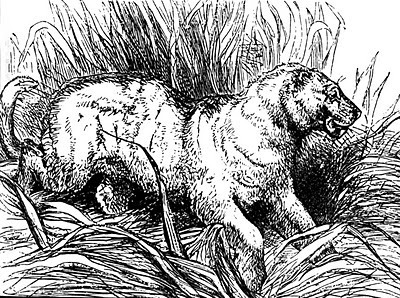 Engraving from the Reverend J.G. Wood's book of the ghost-striped white tiger exhibited in London during the 1820s (Dr Karl Shuker)
Engraving from the Reverend J.G. Wood's book of the ghost-striped white tiger exhibited in London during the 1820s (Dr Karl Shuker)In his definitive work La Règne Animal (1836-49), the eminent French naturalist Baron Georges Cuvier had published an almost identical description of a white tigress, which may (or may not) have been the same individual as the Exeter Change specimen.
GOLDEN TABBY TIGERS
No less spectacular than the white tigers and snow tigers, in recent years a third, equally remarkable strain known variously as the golden tabby, ginger, or strawberry tiger has come to public prominence. These extremely large animals are characterised by a mellow golden-hued pelage, patterned with faint, darker stripes, and complemented by snowy-white underparts.
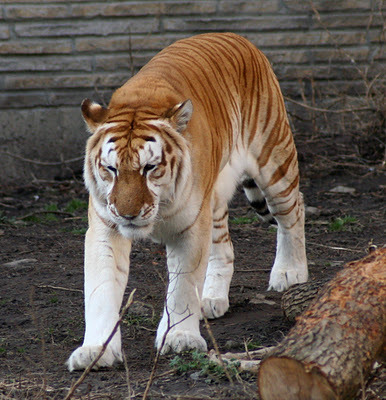 A golden tabby tiger, revealing its extensive white underparts and subdued golden upperparts
A golden tabby tiger, revealing its extensive white underparts and subdued golden upperpartsThese tigers are all either homozygous or heterozygous for the dominant wild-type allele of the Full Colour gene, but some investigators have claimed that they are also likely to be homozygous for the Wide Band gene, arguing that this would explain their paler, golden fur dorsally, their reduced striping, plus their snow-white underparts and lower flanks. One such claim was present on the Wikipedia page for white tigers when I accessed it today (31 January 2012):
"...there is a separate "wide-band" gene affecting the distance between the dark bands of colour on agouti hairs. An orange tiger who inherits two copies of this wide-band gene becomes a golden tabby; a white who inherits two copies becomes almost or completely stripeless."
In reality, however, as noted in my snow tiger section above, there is no firm evidence that a Wide Band gene even exists, at least in domestic cats, and I have yet to see any published scientific research verifying its presence in tigers either.
Alternatively, and far more likely, their coat's appearance may have the same genetic explanation as that of golden tabby domestic cats, which is documented as follows in Robinson's Cat Genetics for Breeders and Veterinarians (1999):
"Non-silver agouti cats (ii) [i.e. homozygous for the recessive inhibitor-preventing non-silver allele of the Inhibitor of Colour gene, and either homozygous or heterozygous for the dominant agouti allele of the Agouti gene] bred from heterozygous chinchilla cats (Ii) are not identical to other tabbies...but are much brighter in color. They have been given the name of golden tabby, Chinchilla golden or shaded golden. In goldens, the agouti band of the tabby pattern is widened. Examination of hairs from goldens reveals that these are nearly all yellow with a dark tip and a slight gray undercolor at the base."
Although specimens of golden tabby tigers were formerly recorded in the wild in India, with records dating back to the onset of the 20th Century, they suffered the same tragic fate as wild white tigers – shot by hunters as unusual trophies, the last just outside Mysore Pradesh during the early 1930s. Today, only around 30 individuals exist in zoos around the world, the first one being born to normal Bengal tiger parents in 1983 at Dr Josip Marcan's Adriatic Animal Attractions in Deland, Florida; and all of today's are descended from Bhim, a male white tiger sired by Tony, who was a part-Siberian white tiger.
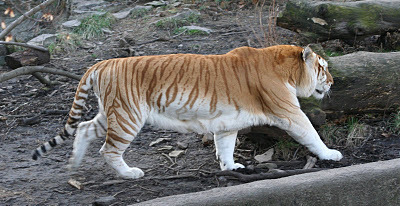 Golden tabby tiger, side view
Golden tabby tiger, side viewAs with white tigers, golden tabby specimens are unquestionably very eyecatching. Nevertheless, they too have a price to pay for their strange beauty. As I learned from zoo cat expert Graham Law, they suffer from weak pelvic girdles, thus rendering them less able to climb than their normal-coloured brethren.
A sad verification, perhaps of Shakespeare's famous line: "All that glisters is not gold"?
Published on January 31, 2012 20:03
WHITE LIONS AND WHITE TIGERS - SEEKING A GENETIC EXPLANATION
 Leucistic white lion (Stano Novak-Wikipedia) and Rewa-type white tiger (Chris Brack)
Leucistic white lion (Stano Novak-Wikipedia) and Rewa-type white tiger (Chris Brack)"A white lion is magic, and if you see one, you should not say."
Opening words in the 1979 film 'The White Lions' (dir: Mel Stuart)
Native South African legends have long told of magical, elusive white lions inhabiting the Kruger National Park and the neighbouring Transvaal, but with no confirmed sightings by scientists, these leonine phantoms were not taken seriously by the zoological world – until 1977, that is, when zoologist Chris McBride announced to stunned press reporters across the globe that for the past two years, on a private game reserve called Timbavati adjacent to the Kruger, he had been studying and protecting three blue-eyed, snowy-white lions.
Tragically, as revealed in McBride's books The White Lions of Timbavati (1977) and Operation White Lion (1981), one of them, a female called Phuma, was subsequently shot by a poacher. As a result, the remaining two, Temba (male) and Tombi (female), together with their normal tawny-furred brother, Vela, were successfully captured and rehoused within South Africa's National Zoo in Pretoria for their own safety. Since then, many white lions have been bred from them and from others in captivity; there are currently around 300 individuals worldwide.
 Model of a blue-eyed Timbavati white lion (Dr Karl Shuker)
Model of a blue-eyed Timbavati white lion (Dr Karl Shuker)A white lion breeding programme is presently underway at Inkwenkwezi Private Game Reserve in South Africa's Eastern Cape province. In 2009, moreover, confirming that their coat colouration does not prevent them from hunting efficiently, an entire pride of captive-bred white lions was successfully introduced into the wild – the climax of a project initiated in 2003 by the Global White Lion Protection Trust (GWLPT), founded by author and conservationist Linda Tucker in 2002 (click here to visit the GWLPT's website).
 Blue-eyed Timbvati-type white lion, the focus of conservation efforts by the Global White Lion Protection Trust (Linda Tucker-Global White Lion Protection Trust)
Blue-eyed Timbvati-type white lion, the focus of conservation efforts by the Global White Lion Protection Trust (Linda Tucker-Global White Lion Protection Trust)Genetically, white lions are an intriguing phenomenon. Traditionally, it has been stated that some of them, including the original Timbavati trio, owe their white coat and blue eyes to the chinchilla condition – the same genetic condition claimed for the blue-eyed white tigers of Rewa and many of those now in captivity worldwide, as well as for chinchilla-coated domestic cats. As will be explained later, however, this genetic explanation is far more complex than that.
A light-grey cub deemed (tentatively) to be a chinchilla specimen by felid geneticist Roy Robinson back in the 1980s had been born at Alabama's Birmingham Zoo in 1974. However, this individual was darker than the Timbavati trio.
LEUCISTIC LIONS
In contrast to the Timbavati-type lions, other white lions have normal eye colouration, and merely appear extremely pale, even blonde, versions of normal lions. This abnormally pale, even washed-out appearance has been reported from many other species too, and is known as leucism.
 Leucistic white lion (Dr Karl Shuker)
Leucistic white lion (Dr Karl Shuker)Unlike albinism (with which it is often confused), in which only the production of dark pigment (eumelanin) is affected, leucism is caused by the failure during an animal's embryonic development of some or all of the actual pigment cells themselves to differentiate or to migrate properly from the neural crest (where they originate) to the skin, fur, scales, or feathers. And because all types of pigment cell differentiate from the same multi-potent precursor cell type, this means that leucism can cause the reduction of all types of pigment, not just one, resulting in the affected animal exhibiting a characteristic faded or washed-out appearance.
 Leucistic white lioness (Dr Karl Shuker)
Leucistic white lioness (Dr Karl Shuker)I saw my first leucistic white lions in 2004, while staying at the Mirage Hotel during a holiday on The Strip in Las Vegas. In the grounds of the Mirage is 'The Secret Garden of Siegfried & Roy' – a wildlife park owned by these world-famous American stage magicians – where leucistic white lions, as well as white tigers and even a snow tiger (see later), are exhibited.
 Visiting 'The Secret Garden of Siegfried & Roy' at the Mirage Hotel, Las Vegas (Dr Karl Shuker)
Visiting 'The Secret Garden of Siegfried & Roy' at the Mirage Hotel, Las Vegas (Dr Karl Shuker)DISENTANGLING THE CHINCHILLA CONDITION IN WHITE BIG CATS
The chinchilla condition - traditionally (but no longer) deemed to be a phenotypic (external) expression of partial albinism, as well as the explanation for white coats (and also blue eyes) in big cat species such as the lion and tiger - has a somewhat confusing, controversial history, as now revealed.
The leading expert on cat genetics for several decades was Roy Robinson, and the three editions of his book Genetics for Cat Breeders (1971, 1977, and 1991) were internationally recognised as the standard published work on this subject. Accordingly, some years after his death it was decided that his book was still so significant that it should be updated again, incorporating all of the most recent discoveries and developments in its field. In 1999, this new, fourth edition was published. Entitled Robinson's Genetics for Cat Breeders and Veterinarians, it was co-written by four modern-day authorities – Carolyn M. Vella, Lorraine M. Shelton, John J. McGonagle, and Terry W. Stanglein, and it is this publication that I have used throughout my own present investigations as my principal source of information concerning cat genetics – especially when, as will now be seen, some online sources of information on this subject are decidedly contentious and contradictory.

As recently as 1989, when my book Mystery Cats of the World was published, the chinchilla or silver condition was still deemed by some authorities to be caused by a particular recessive mutant allele (gene form) of the Full Colour gene C – certain recessive mutant alleles of which are known to be responsible for various complete or partial albino conditions. This is why chinchilla specimens used to be referred to as chinchilla albinos. Nowadays, conversely, the chinchilla condition is no longer attributed to any allele of the Full Colour gene. Instead, when exhibited by domestic cats it is considered to be due to the combined expression of the dominant alleles of the Inhibitor of Colour gene I (aka the Silver gene), and the Agouti gene A. Together, these alleles inhibit the development of the yellow pigment phaeomelanin in pigment bands on the hairs in the cat's undercoat to such an extent that, in its most extreme form, the hair shaft is entirely white or silver, with any pigment restricted to the very tip of the hair.
To quote from Robinson's Genetics for Cat Breeders and Veterinarians:
"The dominant inhibitor gene I suppresses pigment fed into the growing hair. This results in the typical expression of white hairs with colored tips...That expression ranges from a barely perceptible white band at the base of the hairs next to the skin, to an almost completely white animal with the pigment restricted to the extreme hair tips...The smoke cat is the non-agouti [recessive, aaI-] expression...while the silver [i.e. the chinchilla] is the agouti [dominant, A-I-] form. The inhibitory qualities of the agouti protein increase the effect of this form of pigment inhibition – silver cats have more white undercoat than smokes."
However, this presents a problem in relation to white big cats For whereas the inhibitor allele of the Inhibitor of Colour gene and the agouti allele of the Agouti gene, which are both present in chinchilla domestic cats, are both dominant, captive breeding programmes have confirmed that in white lions and also in white tigers, the white coat colouration is a recessive trait.
Certain websites make a very erroneous claim concerning the genetics of white lions - epitomised by the following statements contained in Wikipedia's white lion page when accessed by me today (31 January 2012):
"Their white colour is caused by a recessive gene known as the chutiya or color inhibitor gene...The chinchilla mutation, a recessive gene, gives white lions their unusual colors. A similar gene also produces white tigers...the chinchilla mutation that inhibits the deposition of pigment along the hair shaft, restricting it to the tips. The less pigment there is along the hair shaft, the paler the lion."
(Reading this Wikipedia page will also reveal that it confuses matters further by trying to explain leucism as an expression of this so-called "recessive gene" for chinchilla too! Whoever wrote this page's genetics section presumably did not check Wikipedia's own page on leucism first, which does explain this condition correctly.)
In reality, however, as Robinson's cat genetics book clearly states, the allele of the Inhibitor of Colour gene that inhibits the deposition of pigment along the hair shaft is dominant, not recessive. There is a recessive allele of this gene, but that prevents colour inhibition, resulting instead in golden-furred animals, not white ones (see later here for details regarding the genetic basis of mutant golden-furred tigers).
Evidently, therefore, the chinchilla condition in domestic cats cannot be homologous with the white coat condition in lions and tigers (as originally assumed). Consequently, blue-eyed white lions and tigers should no longer be (though they often still are) referred to as chinchilla mutants - because whatever genetic condition is responsible for their white coat (something that has yet to be conclusively determined), it is evidently not the combination of the dominant Agouti allele and the dominant Inhibitor of Colour allele (i.e. the combination that does induce the chinchilla condition in domestic cats).
WHITE TIGERS
One of the most evocative descriptions of a white tiger that I have ever seen appeared in a Wild About Animals magazine article from December 1989 dealing with albinos:
The golden paint has been forgotten. Instead of fiery sun, we bathe in the cool moonlight of this wonderful creature. Nature's mistake is our magnificent gain.
Certainly, the sight of a sepia-striped, ivory-furred tiger, gazing into your eyes through its own twin orbs of glacial blue, is unforgettable - but what is the history of these ethereal creatures?
 A white tiger – not burning bright but moonlight white (Chris Brack)
A white tiger – not burning bright but moonlight white (Chris Brack)White tigers have been reported from many parts of India and its immediate neighbours (as well as from China and even Korea), and appear to have existed for some considerable time. Indeed, the earliest known record dates back to 1561, when the Mogul emperor Akbar slayed a tigress that attacked his royal cavalcade near Gwalior. Two paintings dating from his reign and depicting this scene exist – appearing in his great work, Akbar Nama; one of these reveals that two of the tigress's cubs were white.
Similarly, the inhabitants of Assam have known of white tigers since time immemorial, and believe that anyone who kills one will certainly die himself soon after. Sadly, not everyone shares this conviction, and their striking appearance has inevitably made white tigers prime targets for big game hunters. In The Royal Natural History (1894-1896), Dr Richard Lydekker recorded a white tiger shot in Upper Assam during March 1889, and in 1891 one was reported from Poona. Pollock and Thom listed several white tigers in 1900 from Burma and the Jynteah hills of Meghalaya; and Indian wildlife researcher Dr E.P. Gee documented the sighting of two specimens (one of which was later shot) towards the onset of the 20th Century at an Assam tea estate - renamed Bogobagh ('White Tiger') tea estate afterwards.
Between 1907 and 1933, the Journal of the Bombay Natural History Society included no less than 17 reports of shot white tigers, including one in the Dhenkanal State, Orissa, in 1909; another during 1910 in the Bilaspur district of what was then called the Central Provinces; and two in the district of Bhagalpur in Bihar sometime around 1926. More were shot during the 1920s and 1930s, including 15 in Bihar alone! On 22 January 1939, a specimen was killed by the Nepalese prime minister at Barda camp in Terai Nepal.
 A white tiger (Dr Karl Shuker)
A white tiger (Dr Karl Shuker)Some time before World War I, several white tigers frequented the area of jungle where the districts of Mandla and Bilaspur border on Rewa. In December 1915, one of these (a two-year-old male) was captured near Sohagpur, by the Maharajah Gulab Singh of Rewa. He exhibited it at his summer palace for the next five years, until its death, whereupon it was stuffed and presented to King George V. During later years, eight white tigers were shot in the Rewa forests, the last of which, a male, was bagged by the new Maharajah in 1947.
Disturbingly (though not unexpectedly, in view of such deplorable depletion), sightings of white tigers in the wild within more recent times have been few and far between. Indeed, the last confirmed individual on record appears to have been spied (and, yet again, shot!) in 1958 near Hazaribagh, Bihar, and its skin was displayed at a Calcutta taxidermist's shop. Fortunately, however, not all white tigers shared this tragic fate, and it is the history of one of these lucky few that explains why white tigers still exist today.
Russian porcelain figures of white tigers (Dr Karl Shuker)
On 27 May 1951, a male white tiger was captured alive in Rewa, and was housed within the now-disused summer palace of the Maharajah. This specimen was the famous Mohan, sire of the pure strain of white Bengal tigers subsequently exhibited in zoos ands circuses all over the world. Mohan was mated with many different tigers, all normal-coloured at first, from which only normal-coloured offspring were produced. However, when one of these was itself mated with Mohan, white tiger cubs were at last obtained, and the strain has thrived ever since, with new tigers introduced intermittently in order to strengthen and perpetuate the line. (Moreover, white tigers have also appeared spontaneously in other captive tiger lineages elsewhere, showing that the genetic basis for white tigers is more widely distributed through the world tiger population than once assumed.)
This captive-breeding programme was studied in depth by Hong Kong University zoologists Drs Ian W.B. Thornton and K.K. Yeung, together with Dr K.S. Sankhala from Delhi Zoological Park, and in 1967 the trio published a Journal of Zoology paper. In it, they proposed that the white tiger form was caused by a recessive mutant allele when present homozygously (i.e. represented by two copies, as opposed to just one, or none at all).
 Seen Siegfried and Roy's white tigers, bought the t-shirt! (Dr Karl Shuker)
Seen Siegfried and Roy's white tigers, bought the t-shirt! (Dr Karl Shuker)As already discussed above regarding white lions, until as recently as the late 1980s some authorities still assumed that it must be a certain recessive mutant allele of the Full Colour gene (and wrongly deemed back then to produce the chinchilla coat condition in domestic cats) that was responsible for a white tiger's coat colouration, thereby mistakenly categorising white tigers as partial albinos. However, it is now known that no such allele of the Full Colour gene exists. Instead, in domestic cats it is the combined effect of the dominant allele of the Agouti gene and the dominant allele of the Inhibitor of Colour gene that is responsible for creating the chinchilla coat.
White tigers mated with white tigers can only produce white tigers, whereas normal tigers mated with normal tigers usually produce only normal tigers but can occasionally produce white tigers too, so it is clear that whichever allele is responsible for white tigers, it is both homozygous and recessive. Consequently, as once again with the white lion scenario, the genetic basis of the white tiger's coat colour cannot involve the chinchilla-producing dominant wild-type allele of the Agouti gene and the dominant wild-type allele of the Inhibitor of Colour gene.
It is puzzling, therefore, that certain websites persist in claiming – wrongly - that the white coat of white tigers is due to a recessive allele of the Inhibitor of Colour gene. The Wikipedia entry for white tigers (as accessed by me today - 31 January 2012) contains a prime example of this, while, ironically, attempting to diffuse the confusion that had been created by researchers in earlier decades wrongly identifying the chinchilla condition as the expression of an albino-related allele of the Full Colour gene:
"Confusion has arisen due to the misidentification of the so-called chinchilla gene (for white) as an allele of the albino series [i.e. the Full Colour gene's series of alleles]: publications prior to the 1980s [and after!] refer to it as an albino gene. The mutation is recessive to normal colour...the inhibitor ("chinchilla") gene affects the colour of the hair shaft."
There is a recessive allele of the Inhibitor of Colour gene. However, as already noted here, when this allele is expressed in the cat's external appearance, i.e. its phenotype (which only occurs when present homozygously because it is a recessive allele), it actually prevents the inhibition of pigment, resulting instead in golden-furred individuals, not white ones.
In terms of coat colouration, therefore, white tigers cannot be homologous genetically with those domestic cats that exhibit the chinchilla coat condition. This is why white tigers (and also white lions, leopards, etc) should no longer be (but often still are) referred to as chinchilla mutants.
Interestingly, there is a recessive mutant allele of the Full Colour gene that does produce blue-eyed albinos in domestic cats. However, the coat of such animals is entirely white, with no dark markings of any kind. Hence this allele cannot be responsible for white tigers, as their coat is patterned with black, grey, or brown stripes. Equally, the Dominant White gene, responsible for many blue-eyed white domestic cats, cannot be responsible for white tigers (or lions), because, as its name suggests, genetically it is dominant, not recessive.
 White tiger
White tigerTragically, the white tiger's beauty is marred by the accompanying presence of certain undesirable afflictions. Most notable of these is a congenital abnormality of the central visual pathway. Some of the optic nerve fibres connect up with the wrong side of the brain - a condition that can be associated with cross-eyes (strabismus).
SNOW TIGERS, PINK-EYED ALBINO TIGERS, AND GOLDEN TABBY TIGERS
Typical white tigers possess narrow, but clearly discernible brown, black, or grey stripes, but very occasionally a specimen has been born that totally or virtually lacks any degree of striping. These white stripeless tigers are popularly referred to as snow tigers, of which perhaps the most famous examples are the magnificent individuals owned by American stage magicians Siegfried and Roy. They own a number of white tigers too, as well as white lions, which can be seen on display in their private wildlife park, 'The Secret Garden of Siegfried & Roy', at the Mirage Hotel in Las Vegas. While staying at the Mirage during my 2004 holiday on the Strip, I was able to see these exotic big cats personally.
 Alongside a startlingly-realistic life-sized cut-out of Siegfried & Roy with one of their snow tigers at The Mirage Hotel, Las Vegas (Dr Karl Shuker)
Alongside a startlingly-realistic life-sized cut-out of Siegfried & Roy with one of their snow tigers at The Mirage Hotel, Las Vegas (Dr Karl Shuker)Other notable snow tigers exhibited in captivity include various specimens at Cincinnati Zoo (the first zoo, back in the 1980s, to have such animals; two cubs born at Liberec Zoo in the Czech Republic during the 1990s; and Artico, born in May 2004 to normal tiger parents at a wildlife refuge in Alicante, Spain.
 A rare snow tiger, in which body markings are scarcely visible (Alan Pringle)
A rare snow tiger, in which body markings are scarcely visible (Alan Pringle)Genetically, a snow tiger probably exhibit the same genetic make-up for coat colouration displayed by white tigers but some investigators have speculated that it may additionally possess a gene that has been dubbed the Wide Band gene. This latter allele reputedly doubles the width of the yellow band of pigment on the hair shafts of the white tiger's fur. As most of its fur is already white, such an allele would have no visible effect – except, that is, on the hairs of the fur's stripes, which even in white tigers retain brown or otherwise dark pigmentation. Its influence on these hairs, however, would cause the width of their pigmented sections to be greatly reduced, so much so that the stripes would be virtually or even totally lost, resulting in a snow-white, stripeless tiger.
The fundamental problem with this ostensibly plausible theory is that there is no conclusive evidence that the Wide Band gene actually exists. To quote yet again from the standard work on cat genetics, Robinson's Cat Genetics for Breeders and Veterinarians (1999):
"It has been proposed that the chinchilla and goldens [see later section on golden tabby tigers] owe their unique phenotype to the presence of a wide band gene provisionally denoted by Wb. However, breeding studies appear to contradict this in favor of a more polygenetic model that possibly acts by increasing the amount of agouti protein produced in the melanocytes."
Snow tigers, which normally have blue eyes like white tigers, should not be confused with true or complete albino tigers, which not only lack stripes but also possess pink eyes. These are exceedingly rare. As I documented in Mystery Cats of the World (1989), however, during 1922 two sub-adult specimens were shot in the former north-east Indian state of Cooch Behar. As their pink eyes were verified, these tigers were clearly homozygous for the complete albino mutant allele of the Full Colour gene, which is responsible for pure white pelage and pink eyes in a range of mammalian species.
In his Illustrated Natural History (1859-63), the Reverend J.G. Wood reported that what may (or may not!) have been a similar specimen was on display at the Exeter Change Menagerie in London during the 1820s, which he described as follows:
"The colour of this animal was a creamy white, with the ordinary tigerine stripes so faintly marked that they were only visible in certain lights."
Wood also included an engraving of it (reproduced here) in his book, a copy of which I own. Unfortunately, no mention was made of its eye colour – because had they been blue (as opposed to pink), this enigmatic tiger with only the most ghostly of stripes might have been an early example of a snow tiger. Indeed, this has been claimed as fact on some websites, but as there does not appear to be any record verifying the colour of its eyes, such claims clearly cannot be confirmed.
 Engraving from the Reverend J.G. Wood's book of the ghost-striped white tiger exhibited in London during the 1820s (Dr Karl Shuker)
Engraving from the Reverend J.G. Wood's book of the ghost-striped white tiger exhibited in London during the 1820s (Dr Karl Shuker)In his definitive work La Règne Animal (1836-49), the eminent French naturalist Baron Georges Cuvier had published an almost identical description of a white tigress, which in fact may have been one and the same specimen as the Exeter Change individual.
GOLDEN TABBY TIGERS
No less spectacular than the white tigers and snow tigers, in recent years a third, equally remarkable strain known variously as the golden tabby, ginger, or strawberry tiger has come to public prominence. These extremely large animals are characterised by a mellow golden-hued pelage, patterned with faint, darker stripes, and complemented by snowy-white underparts.
 A golden tabby tiger, revealing its extensive white underparts and subdued golden upperparts
A golden tabby tiger, revealing its extensive white underparts and subdued golden upperpartsThese tigers are all either homozygous or heterozygous for the dominant wild-type allele of the Full Colour gene, but some investigators have claimed that they are also likely to be homozygous for the Wide Band gene, arguing that this would explain their paler, golden fur dorsally, their reduced striping, plus their snow-white underparts and lower flanks. One such claim was present on the Wikipedia page for white tigers when I accessed it today (31 January 2012):
"...there is a separate "wide-band" gene affecting the distance between the dark bands of colour on agouti hairs. An orange tiger who inherits two copies of this wide-band gene becomes a golden tabby; a white who inherits two copies becomes almost or completely stripeless."
In reality, however, as noted in my snow tiger section above, there is no firm evidence that any such Wide Band gene even exists.
Instead, it is far more likely that their coat's appearance has the same genetic explanation as that of golden tabby domestic cats, which is documented as follows in Robinson's Cat Genetics for Breeders and Veterinarians (1999):
"Non-silver agouti cats (ii) [i.e. homozygous for the recessive inhibitor-preventing non-silver allele of the Inhibitor of Colour gene, and either homozygous or heterozygous for the dominant agouti allele of the Agouti gene] bred from heterozygous chinchilla cats (Ii) are not identical to other tabbies...but are much brighter in color. They have been given the name of golden tabby, Chinchilla golden or shaded golden. In goldens, the agouti band of the tabby pattern is widened. Examination of hairs from goldens reveals that these are nearly all yellow with a dark tip and a slight gray undercolor at the base."
Although specimens of golden tabby tigers were formerly recorded in the wild in India, with records dating back to the onset of the 20th Century, they suffered the same tragic fate as wild white tigers – shot by hunters as unusual trophies, the last just outside Mysore Pradesh during the early 1930s. Today, only around 30 individuals exist in zoos around the world, the first one being born to normal Bengal tiger parents in 1983 at Dr Josip Marcan's Adriatic Animal Attractions in Deland, Florida; and all of today's are descended from Bhim, a male white tiger sired by Tony, who was a part-Siberian white tiger.
 Golden tabby tiger, side view
Golden tabby tiger, side viewAs with white tigers, golden tabby specimens are unquestionably very eyecatching. Nevertheless, they too have a price to pay for their strange beauty. As I learned from Graham Law, they suffer from weak pelvic girdles, thus rendering them less able to climb than their normal-coloured brethren.
A sad verification, perhaps of Shakespeare's famous line: "All that glisters is not gold"?
The history of white lions and white tigers makes fascinating reading, but a crucial question remains unanswered. Namely, what is the genetic basis for their existence? For all of the reasons given above, it seems clear to me that the online-cited explanation of the Inhibitor of Colour gene's dominant allele in combination with the Agouti gene's dominant allele being responsible is fatally flawed by the simple fact that white fur in these cats is a recessive trait.
Or have I missed something?
This is where, gentle reader, you come in. If there is anyone out there with information or experience of cat genetics, especially the genetics of white big cats, that is of relevance to the subjects investigated and documented here, please do send in details, because I'd very much like to learn of a plausible solution to this most intriguing mystery.
 Wearing my Siegfried & Roy white tiger & white lion t-shirt
Wearing my Siegfried & Roy white tiger & white lion t-shirt
Published on January 31, 2012 20:03
January 25, 2012
"I NEVER SAW A PURPLE COW" – WELL, NOW I HAVE (SORT OF...)
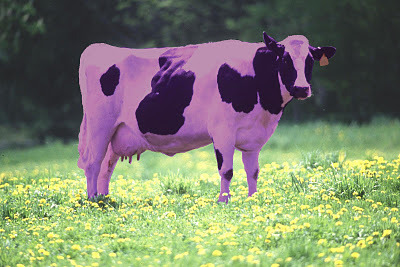
My own idea of what a purple cow may look like (Public domain photograph adapted by Dr Karl Shuker)
One of the shortest but most famous of all nonsense poems is 'The Purple Cow', penned by American author Gelett Burgess (1866-1951). It originally appeared in the first issue of The Lark, a magazine published in 1895 that was co-edited and (at least initially) largely written by Burgess. Here is the illustrated page from The Lark containing this poem:
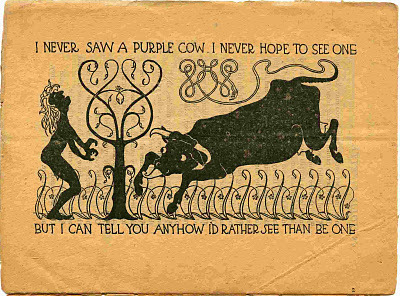
It is well-documented that this humble little verse attracted such attention in the years to come that eventually Burgess was driven to distraction by its unexpected yet unrivalled popularity – to the extent that he announced publicly how he wished that he had never written it. He even wrote the following humorous parody of it to that effect:
Ah, yes, I wrote the "Purple Cow" —
I'm Sorry, now, I wrote it;
But I can tell you Anyhow
I'll Kill you if you Quote it!
 Gelett Burgess
Gelett BurgessOutside poetry circles, 'The Purple Cow' is also often used nowadays as a symbol or representation of any highly unlikely occurrence or object encountered in life – something so unusual that it couldn't possibly exist...
Except that in its original bovine connotation, it could and has done – at least twice, in fact!
Having said that, however, until today I only knew of one real-life example – this one:
In 1948, the head of Florida's State Nutrition Laboratory was very bemused by the discovery that one of the cows present in a herd grazing on poor land in this U.S. state was purple in colour. Needless to say, this herd and in particular its singularly-shaded member soon attracted detailed scientific attention, and the cows were all found to be very mineral-deficient. Following a course of feeding upon a natural, balanced diet, however, they became much more healthy and appeared in no way different from any others – all except one, that is.
For although it too became much more healthy, the purple cow never lost its extraordinary hue. And despite close study, neither the reason for its remarkable colouration having arisen in the first place nor the reason for its persistence following a proper diet was ever uncovered.
Now, moreover, as I learnt today, courtesy of an online news video kindly brought to my attention on Facebook by Lazarro Baca, there is a second specimen on record. On 17 January 2012, media worldwide published reports of a certain male calf lately born in Jezdina - a small mountain village close to the Serbian city of Čačak - which is attracting considerable local interest and publicity, due to its remarkable purple colouration.
Having said that, in videos and still photos of it that I have seen so far, such as those included in this present blog post of mine, the animal variously looks grey and white or very pale lilac and white. In view of the appreciable attention that it is receiving, however, I am assuming that it appears more purple in colour when seen in the flesh.
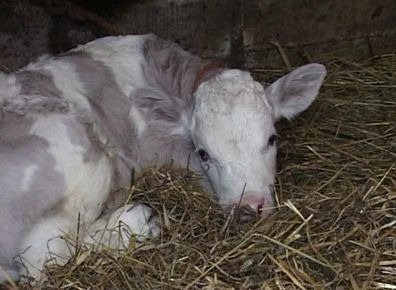 Serbia's purple calf
Serbia's purple calfIts owner is farmer Radmila Glavonjić, who has stated that his unique calf will certainly not be sent to the slaughterhouse. Due to its resemblance to the famous purple cow emblem of Milka chocolate, Radojka would have named it Milka had it been female, but as it is male, he is toying with the idea of naming it either Milkan or Sladjan ('Cutie' in Serbo-Croat).
Veterinary surgeons who have examined this calf claim that it is perfectly healthy, and consider its unwonted colouration to be of genetic rather than external origin. It will be interesting to see whether the animal retains its purple shade as it matures.
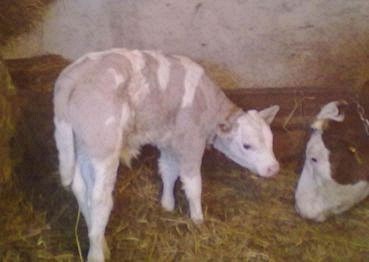 Serbia's purple calf with its mother
Serbia's purple calf with its motherSpeaking about the purple cow logo of Milka chocolate, cryptozoological colleague Markus Bühler has shared the following fascinating information with me:
"I am not completely sure if this is an urban legend, but apparently many children who lived in towns and had never seen a cow in life really assumed that cows are purple, as a result of the wide precence of purple Milka cows on tv and on chocolate."
Wonderful! Thanks Markus!
A short video of Serbia's purple calf can be viewed on YouTube here .
Published on January 25, 2012 21:08
January 21, 2012
FELIS - LOST CONSTELLATION OF THE CAT
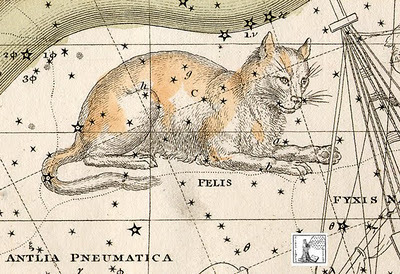 Felis, as depicted in Alexander Jamieson's 1822 star atlas
Felis, as depicted in Alexander Jamieson's 1822 star atlasToday, only 88 constellations in the night sky are formally recognised by the International Astronomical Union (IAU), but many additional ones were once described and named too. One of these was Felis, the Cat, which was originally designated in 1799 by French astronomer Joseph Jérôme de Lalande, a noted cat-lover who had lamented the domestic cat's absence in a sky populated by no less than three different domestic dog constellations (Canis Major, Canis Minor, and Canes Venatici), as well as three wild cats (Leo, Leo Minor, and Lynx). And so Felis, situated between the constellations of Antlia (the Air Pump) and Hydra (the Water Snake), was duly added to the list, becoming the thirty-fourth animal constellation (albeit a rather small one).
Accordingly, in 1801 it was portrayed in German astronomer Johann Elert Bode's magnificent atlas of the heavens, Uranographia Sive Astrorum Descriptio (the largest star atlas ever published, containing the positions of over 17,000 stars), as well as in a map of 1805 prepared once again by Bode.
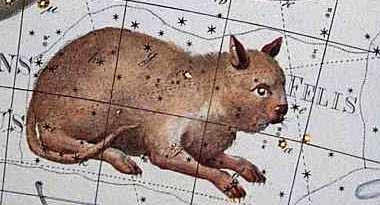 Felis, as depicted in Bode's Uranographia (1801)
Felis, as depicted in Bode's Uranographia (1801)It also appeared in an equally spectacular star atlas by Alexander Jamieson, entitled Celestial Atlas Comprising a Sistematic [sic] Display of the Heavens, which was published in 1822.
In later years, however, just like numerous other once-recognised constellations, Felis lost its place in the night sky. After having been deemed by French astronomer Nicolas Camille Flammarion to be superfluous, it was not included in the final list of 88 constellations drawn up and officially approved by the IAU in 1922. And that is why – just like other 'extinct' constellations such as Rangifer the Reindeer, Bufo the Toad, Cerberus the Three-Headed Hound of Hades, Hippocampus the Sea Horse, Noctua the Owl, Limax the Slug, Apis the Bee, Dentalium the Tooth Shell, Gallus the Rooster, Anguilla the Eel, and (truly!) Manis the Pangolin, to name but a few - Felis the Cat no longer gazes down upon us from the Heavens far above.
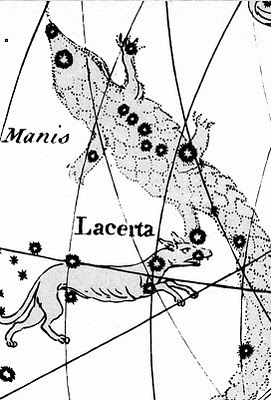 Manis - the Pangolin constellation - as designated and depicted in 1754 by John Hill within his Urania: A Compleat View of the Heavens; Containing the Ancient and Modern Astronomy, in Form of a Dictionary
Manis - the Pangolin constellation - as designated and depicted in 1754 by John Hill within his Urania: A Compleat View of the Heavens; Containing the Ancient and Modern Astronomy, in Form of a DictionaryThis blog post is extracted from my forthcoming book, Last Night I Saw The Strangest Cat: A Cat-alogue of Feline Magic, Mythology, and Mystery.
Published on January 21, 2012 22:43
Karl Shuker's Blog
- Karl Shuker's profile
- 45 followers
Karl Shuker isn't a Goodreads Author
(yet),
but they
do have a blog,
so here are some recent posts imported from
their feed.



